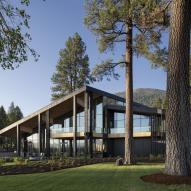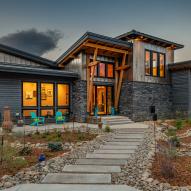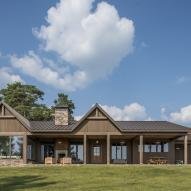BUILDING PRODUCTS DEALER PROFILE
Building Products recently caught Jonathan for an interview where he shared Pioneer Millworks’ and New Energy Works Timberframers‘ history, what we do, how we do it, and why we do it. You can read the article below, or live on their website.
Dealer Profile: Pioneer Millworks
BY CARLA WALDEMAR
Restaurants are frequent customers, such as for this reclaimed American Gothic Oak in an Upstate New York eatery.
PIONEER MILLWORKS
Necessity, they say, is the mother of invention. Well, in this case, the light bulb flashed in the brain not of a mom, but a dad.
Jonathan Orpin, founder and president of Pioneer Millworks, Farmington, N.Y., owned (and still owns) New Energy Works Timber Framers, based in Farmington, and, of course procuring wood for its operation was front of mind. “It was important to look for a stable timber source for the framing business,” Orpin explains, gazing back, “and this part of New York State had always used a certain amount of agricultural timbers.”
So, he reasoned—the light bulb moment—why not reclaim that vintage wood for modern use?
Thus, in 1988, Pioneer Millworks was launched “in a small, ramshackle building in a town not that much bigger,” looking to specialize in salvaged flooring.
“I liked the idea of using timber 50 to 100 years old—material that had undergone a slow drying process, which provided stable lumber. And that wood ended up with a story to tell,” he shares. “There were barns going down—I hate that, but at least we could give that wood new life. Here, in the classic rust belt of America, lots of buildings were built with big timbers. Plus, there’s the environmental aspect of it: Through Pioneer Millworks, the world has gained 23 million bd. ft. of lumber that would have ended up as landfill. We’ve become a major player in changing that direction, converting it for use in homes, restaurants, offices: gorgeous applications.” (A look at the photo gallery on the company’s website backs up his claim.)
That 23 million ft. breaks down into 1,042,000 bd. ft. saved a year, which, Orpin is quick to do the math, would fill a lineup of semis, bumper to bumper, for over 32 miles.
Sounds like a no-brainer start-up. Easy, right? Trust me (and him): It wasn’t. Another facet of the website plays homage to scores of big, complicated and expensive-looking machines resting on Pioneer’s nine-acre site. “We started on the cheap, bootstrapping as we went, buying used equipment. We got word of timber needed for a New Energy project, but we were required to buy the whole building, so we developed ways to use everything, even the sawdust”—it segues into animal bedding—“and chunks, which heated our kiln.”
Pioneer Millworks took hold and grew. Today, the two operations exist side by side, sharing administration and communications, but not manufacturing. “The child became more powerful than the parent. We’re our own best customer,” Orpin states. “We got the word out, one project at a time, as the cliché goes: timber framing that uses our own reclaimed wood in projects—a strong, built-in client.”
Pioneer sells to builders, remodelers and flooring contractors, primarily through its website (there’s no showroom), shipping nationwide. Architects and interior designers prove pivotal in influencing the homeowner’s or building owner’s decisions: “Highly refined design & build clients ask for it,” Orpin explains,” because it’s an attractive alternative to boring bamboo or the oak flooring of a chain restaurant. People love it because there’s a natural honesty to it; plus the amazing textures, with natural variations. And the environmental aspect—we’re not ruining any rainforests. And, of course, there’s the story”—the romance is provided—“behind its former use. These clients are thrilled, so it becomes fun.”
Products offered include timber, barn siding, paneling, countertops, and more. And that timber—awesome in its diversity and lineage—is cherry-picked: over 50 species, grades and specialty items, including teak from a dilapidated Indonesian structure; antique heart pine from a 1905 mill complex; oak from a coal plant of the 1800s; reclaimed hickory, with its contrasting knots and sapwood “that wears well—suitable for dogs and kids;” salvaged bowling lanes; FSC-certified recycled wood panels geared for quick and easy installation, even pairings of engineered wood and antique flooring. And cold storage oak—the Holy Grail of reclaimed wood—white oak flooring from a long-ago cold storage facility.
Projects range from a Manhattan restaurant utilizing a reclaimed gym floor from a Minnesota high school to the Wolverine company store in New York, using old planks salvaged for re-use as wall cladding: “lots of residences, restaurants. And offices: all the progressive, high-tech San Francisco firms. If you can name them, we’ve probably done the wood.” What sells best? “Weathered, rugged wood, and wood with a story.”
And how about supply vs. demand? “It’s always variable, always a challenge, but our supply channels are well-oiled.” (He’s got a network of scouts out sleuthing potential barns or what-have-you, but if he told me more, he’d have to kill me.) Pioneer employs a staff of 40—“good workers, thoughtful, smart—and they care about the environment.” Pioneer’s website personalizes the crew, complete with candid photos and homey bios, thanks to a strong marketing program. “It’s done in-house because we have a complex and personal story to tell,” the boss explains.
Margins must be golden for the highly-coveted antique wood, right? Wrong. “It’s a complex and difficult business,” Orpin claims. “It’s heavily labor-intensive—extracting nails located with a metal detector, for instance. There’s lots of waste, plus complex customer interactions, so we struggle with margins. They’re very, very tight.”
Adding to that challenge is the reality of competition out there—“half a dozen strong national companies and a hundred smaller regional players,” he tallies. So then, why does Pioneer continue to flourish? “Service! We’re very service-oriented,” Orpin is quick to respond. “We come from a custom-design background, so we’re adept at creative solutions. And we serve the hell out of folks: quick turnaround, quick delivery, good communication.
“Over the past 10 years customers have begun demanding delivery yesterday. So we keep a multi-million-dollar inventory on hand. An order can be for the 70,000 sq. ft. that a university recently needed, or just 70 ft. of trim. (We have a $100 minimum.)”
Pioneer, like the rest of us, was buffeted by the recent recession—“Sure, it hurt. But we made a point of no layoffs, no cuts in salaries or benefits. But we tightened margins; we did what we had to do to survive.” And business is not only back—it’s booming. “Last year was our best year ever—up 14%—and this year, even more! Another 14%!”
So, to keep things interesting, Orpin recently chose to open a second location on the opposite coast—a three-acre establishment in Portland, Or.—“for personal growth,” he explains. “In New York, I’m not needed as much on a day-to-day basis. So, I was looking for new mountains to climb. Plus, we have many Pacific Coast clients and do some salvaging out there.” Another light bulb moment.





